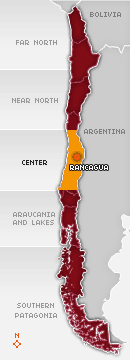Tours and Activities:
The Looms Show Their Art
Mónica Pons Jorge GonzálezIn the area of the Medialuna, we enjoyed the dedication to this task of unique features.

The history of the Chilean huaso rodeo leads us to point out its popularity and the festive atmosphere flaunted by the colleras with their costumes and specially, their poncho.
We reached Dońihue, toured around its almost deserted streets trying to find a hint of the presence of the chamanteras, the women who weave the classic huaso ponchos. In the area of the Medialuna, a kind neighbor located Mrs. Julia Peralta on the same block.
We were welcomed by this lady with the greatest simplicity. Her house stands next to a creek. There was a mud oven and a yard made of dirt and covered by a grapevine arbor, which provides shade in the summer and shelter from the cold in the winter.

In a small room, she showed us her loom and accessories: a hardwood shuttle that prevents the threads from being tangled, and a small spindle that complements the weaving process. All the elements have been particularly polished due to the large number of threads that have gone through them.
We could observe how the weaver dressed the yarn in order to pass the shuttle and then tightened the fabric giving shape to the warp and weft. This is the secret of its unalterable quality. The preparation of the loom and the location of the threads that will start the fabric is what take longer. Some patterns have been repeated since time immemorial and others are imagined by the weaver from scratch.
Both the chamanto and the blanket are straight one-piece ponchos that cover the huasos’ shoulders down to their waist. Many years ago, they used to be embarrilados (barrel-like), as they become narrower at the bottom. Pure coquetry.

The chamanto displays various tasks, patterns made in the loom as the threads are woven: copihues (the national Chilean flower), grapevine leaves, etc. The huasos just wear them when they dress up. Instead, the blanket is plain and bordered by a decorative outline. They are woven with a slightly bright thin imported high-quality thread. The pattern is reversible and it is trimmed by a huincha or strip made of the same fabric that holds the piece together. The garment is made to order and the process takes several months depending on the dedication of the weaver.
The origin of these products dates back to almost two hundred years ago. Some chamantos featuring the quality and firmness of the fabric can be found even today. They used to be longer and worn to fight the cold temperatures. There are no schools where this task may be taught: the secrets of the loom are passed on from generation to generation.

With the most humble attitude, Julia showed us the replica of the chasuble she wove for Pope John Paul II when he visited Argentina and Chile in 1987, with the same loom technique used to weave the chamantos. On the walls of her house, we could see the moment when she and the parson of Dońihue hand the gift in the hands of John Paul II. There are other pictures that show her working on the chasuble and a certificate from the Vatican bearing her name and appreciating her kindness.
We could not help comparing the quiet and simple task performed by the weaver with the strength and distinction of the colleras in the rodeo tasks. Both presences are essential at the medialunas where Chilean huasos celebrate the rodeo.

© 2007-2025 Total or partial reproduction forbidden. Derechos de Autor 675243 Ley 11723


 See also:
See also: 



